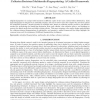Free Online Productivity Tools
i2Speak
i2Symbol
i2OCR
iTex2Img
iWeb2Print
iWeb2Shot
i2Type
iPdf2Split
iPdf2Merge
i2Bopomofo
i2Arabic
i2Style
i2Image
i2PDF
iLatex2Rtf
Sci2ools
SSWMC
2004
2004
Collusion-resistant multimedia fingerprinting: a unified framework
Digital fingerprints are unique labels inserted in different copies of the same content before distribution. Each digital fingerprint is assigned to an intended recipient, and can be used to trace the culprits who use their content for unintended purposes. Attacks mounted by multiple users, known as collusion attacks, provide a cost-effective method for attenuating the identifying fingerprint from each colluder, thus collusion poses a real challenge to protect the digital media data and enforce usage policies. This paper examines a few major design methodologies for collusion-resistant fingerprinting of multimedia, and presents a unified framework that helps highlight the common issues and the uniqueness of different fingerprinting techniques.
| Added | 31 Oct 2010 |
| Updated | 31 Oct 2010 |
| Type | Conference |
| Year | 2004 |
| Where | SSWMC |
| Authors | Min Wu, Wade Trappe, Z. Jane Wang, K. J. Ray Liu |
Comments (0)

